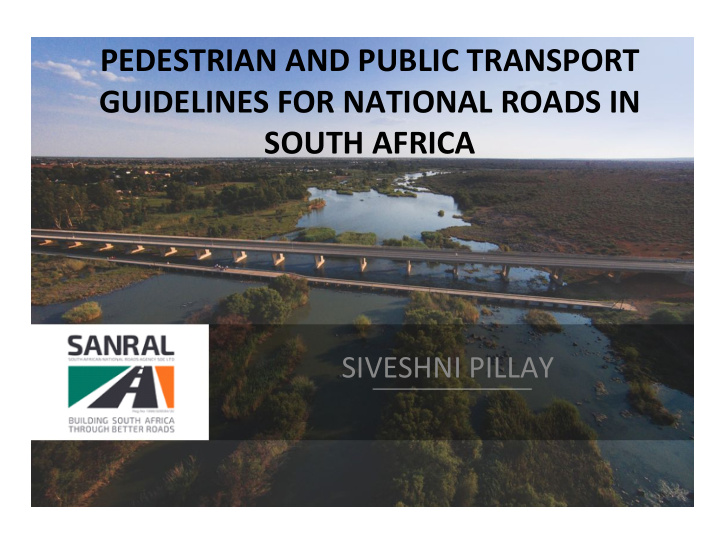



PEDESTRIAN AND PUBLIC TRANSPORT GUIDELINES FOR NATIONAL ROADS IN SOUTH AFRICA SIVESHNI PILLAY
SANRAL AND THE ECONOMY • Historically, SANRAL managed mainly high mobility corridors including freeways. • SANRAL has since taken over additional routes from the provinces, with substantial public transport and pedestrian activities and facilities.
BACKGROUND LEGACY ISSUES Poor Access Management Poor Pedestrian Management (Alongside and crossing the road) Poor Spatial planning (pedestrian generators close to the freeway) Many schools (3403) within 2km of SANRAL roads
Background cont. Public transport activities such as Pedestrians crossing dropping off and picking freeways at grade up passengers alongside national roads SANRAL Public transport modal Informal trading at such CHALLENGES transfer areas locations Pedestrian activities Increased pressure to inside the road reserve accommodate these (pedestrians walking public transport and next to the road/inside pedestrian facilities shoulders)
CURRENT CHALLENGES Many of these inherited with routes taken over i.e Moloto Road, R71, R61
CURRENT CHALLENGES N11– 10km from Middelburg
CURRENT SOLUTIONS N2 George
CURRENT SOLUTIONS N2 North of Durban towards King Shaka International Airport
LEGISLATIVE OVERVIEW • Contrary to popular opinion, there is a way to legally have pedestrians on freeways with the use of proper road signage • DOT – Roads Policy • Critical factor – to implement in the correct environment and with proper control
THE RIGHT APPROACH ??? APPROACH 1 APPROACH 2 Accept reality and manage it • Balance between freeway mobility, public transport and pedestrian accommodation • Ensure safety of both pedestrians an road users
MINDSHIFT – THINK DIFFERENTLY How do we How do we improve Is SANRAL getting accommodate integrated planning involved in public public transport and (SPLUMA)? transport pedestrians operations? responsibly?
HORSES FOR COURSES • Facility on Moloto Road will be different from the N1 Eastern Bypass • Facilities in a rural environment (irrespective of road class) will be different from an urbanised area • Allows in design principles for phased development of an integrated roadway/ public transport/ pedestrian facilities
OBJECTIVES OF THE GUIDELINES • To develop an understanding of the problem • To understand the legal framework for managing pedestrians and public transport activities • To provide a uniform approach for all SANRAL regions • To provide guidance to designers and decision makers through a system approach
UNIVERSAL ACCESS • These guidelines are not about universal access. • Ensure that universal design is considered and designed in all our solutions and implemented as far as practicably possible
FURTHER ADDITIONS • Scholar Patrol : – NRTA allows the MEC to determine conditions and circumstances for organized scholar patrol – Outlines implementation and links to the procedures • Operational Aspects for Public Transport Facilities – Agreements and approvals for the management and maintenance of the facility, enforcement • Public Transport Shelter Guidelines
GUIDELINES FOR BUS SHELTERS • Provides guidelines for bus stops and bus shelters placement and design • Not design standards • Outlines design principles and accessibility • Advantages / Disadvantages of recommended materials
List of Typical Drawings • Class 1 – Urban and rural • Class 2 – divided and Undivided • Class 3 and 4 • Roundabouts • Interchanges – Urban and Rural
ON ROAD FACILITIES – CLASS 1 RURAL
ON ROAD FACILITIES – CLASS 1 RURAL
ON ROAD FACILITIES – CLASS 1 URBAN
INTERSECTIONS – CLASS 1 URBAN
ON ROAD FACILITIES It is proposed that these facilities in order to operate for its intended purpose that SANRAL, jointly with the local authority, undertake : • Operations and maintenance • Provide resources • Keep it clear from informal trading and • Provide security 3D Flythrough Simulation
ON ROAD FACILITIES – CLASS 2 DIVIDED
ON ROAD FACILITIES – CLASS 2 UNDIVIDED
INTERSECTIONS – CLASS 2 URBAN
ROUNDABOUTS – CLASS 2
INTERCHANGES – CLASS 1 URBAN
INTERCHANGES – CLASS 1 URBAN
INTERCHANGES – CLASS 1 URBAN
INTERCHANGE – CLASS 1 URBAN
PEDESTRIANS ALONGSIDE THE ROADWAY Should walkways be allowed inside the road reserve • Yes • How are they separated? • Safe distance away from traffic?
PEDESTRIAN ACCOMODATION – More free flow a facility, the higher the conflict between pedestrians and vehicles: • Slipways • Circles • Single point interchanges • Diverging diamond • Freeway in general
PEDESTRIAN ACCOMODATION cont … • Pedestrians need to be separated preferably physically with barriers to ensure safety and control • Pedestrians feel insecure in enclosed environments • Need to find the necessary mitigation
PEDESTRIAN MOVEMENT AT DIAMOND INTERCHANGES STORMVOEL ROAD
PEDESTRIAN MOVEMENT AT DIVERGING DIAMOND
PEDESTRIAN AND PUBLIC TRANSPORT CONFLICTS N2 Plettenberg Bay
PEDESTRIAN AND PUBLIC TRANSPORT CONFLICTS Solution: Pedestrian Bridge and Drop off and collection Zone
PEDESTRIAN AND PUBLIC TRANSPORT CONFLICTS Completed Solution
CONCLUDING REMARKS • Pedestrians and public transport comprises more than 60% of person movement • SANRAL cannot ignore it, we must have clear guidelines and thresholds to accommodate it • Legally • Good balance between mobility and safety
CONCLUDING REMARKS • Mindshift • Instead off wishing it away rather accept the responsibility to properly incorporate and accommodate it. • SANRAL is getting into the public transport facility operations space
CONCLUDING REMARKS • In principle acceptance in SANRAL • Pilot phase to test the practicalities and workability of the proposed solutions • Encourage consultants to consider the solutions proposed in these guidelines
Recommend
More recommend